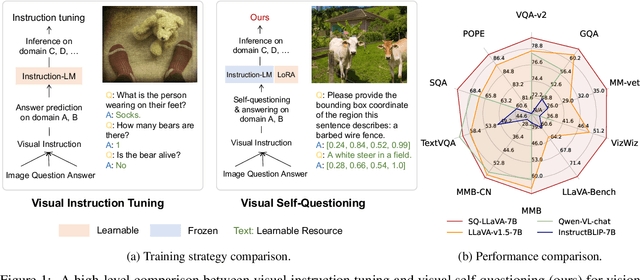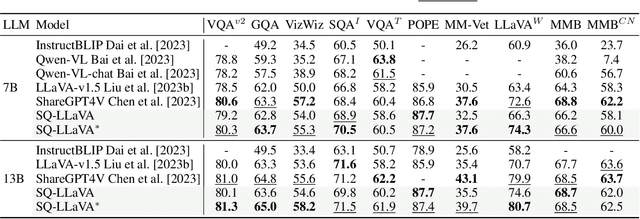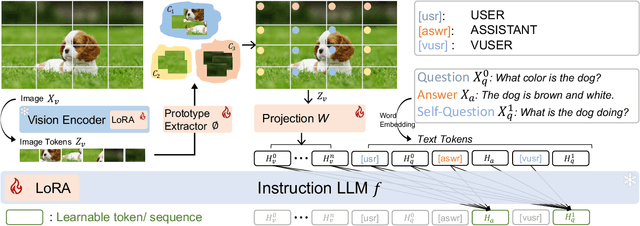Zhiqiang Tao
Evaluating Social Biases in LLM Reasoning
Feb 21, 2025Abstract:In the recent development of AI reasoning, large language models (LLMs) are trained to automatically generate chain-of-thought reasoning steps, which have demonstrated compelling performance on math and coding tasks. However, when bias is mixed within the reasoning process to form strong logical arguments, it could cause even more harmful results and further induce hallucinations. In this paper, we have evaluated the 8B and 32B variants of DeepSeek-R1 against their instruction tuned counterparts on the BBQ dataset, and investigated the bias that is elicited out and being amplified through reasoning steps. To the best of our knowledge, this empirical study is the first to assess bias issues in LLM reasoning.
ChainRank-DPO: Chain Rank Direct Preference Optimization for LLM Rankers
Dec 18, 2024Abstract:Large language models (LLMs) have demonstrated remarkable effectiveness in text reranking through works like RankGPT, leveraging their human-like reasoning about relevance. However, supervised fine-tuning for ranking often diminishes these models' general-purpose capabilities, including the crucial reasoning abilities that make them valuable for ranking. We introduce a novel approach integrating Chain-of-Thought prompting with an SFT-DPO (Supervised Fine-Tuning followed by Direct Preference Optimization) pipeline to preserve these capabilities while improving ranking performance. Our experiments on TREC 2019 and 2020 Deep Learning datasets show that our approach outperforms the state-of-the-art RankZephyr while maintaining strong performance on the Massive Multitask Language Understanding (MMLU) benchmark, demonstrating effective preservation of general-purpose capabilities through thoughtful fine-tuning strategies. Our code and data will be publicly released upon the acceptance of the paper.
Does RAG Introduce Unfairness in LLMs? Evaluating Fairness in Retrieval-Augmented Generation Systems
Sep 29, 2024Abstract:RAG (Retrieval-Augmented Generation) have recently gained significant attention for their enhanced ability to integrate external knowledge sources in open-domain question answering (QA) tasks. However, it remains unclear how these models address fairness concerns, particularly with respect to sensitive attributes such as gender, geographic location, and other demographic factors. First, as language models evolve to prioritize utility, like improving exact match accuracy, fairness may have been largely overlooked. Second, RAG methods are complex pipelines, making it hard to identify and address biases, as each component is optimized for different goals. In this paper, we aim to empirically evaluate fairness in several RAG methods. We propose a fairness evaluation framework tailored to RAG methods, using scenario-based questions and analyzing disparities across demographic attributes. The experimental results indicate that, despite recent advances in utility-driven optimization, fairness issues persist in both the retrieval and generation stages, highlighting the need for more targeted fairness interventions within RAG pipelines. We will release our dataset and code upon acceptance of the paper.
STLLaVA-Med: Self-Training Large Language and Vision Assistant for Medical
Jun 28, 2024Abstract:Large Vision-Language Models (LVLMs) have shown significant potential in assisting medical diagnosis by leveraging extensive biomedical datasets. However, the advancement of medical image understanding and reasoning critically depends on building high-quality visual instruction data, which is costly and labor-intensive to obtain, particularly in the medical domain. To mitigate this data-starving issue, we introduce Self-Training Large Language and Vision Assistant for Medical (STLLaVA-Med). The proposed method is designed to train a policy model (an LVLM) capable of auto-generating medical visual instruction data to improve data efficiency, guided through Direct Preference Optimization (DPO). Specifically, a more powerful and larger LVLM (e.g., GPT-4o) is involved as a biomedical expert to oversee the DPO fine-tuning process on the auto-generated data, encouraging the policy model to align efficiently with human preferences. We validate the efficacy and data efficiency of STLLaVA-Med across three major medical Visual Question Answering (VQA) benchmarks, demonstrating competitive zero-shot performance with the utilization of only 9% of the medical data.
Evaluating Fairness in Large Vision-Language Models Across Diverse Demographic Attributes and Prompts
Jun 25, 2024Abstract:Large vision-language models (LVLMs) have recently achieved significant progress, demonstrating strong capabilities in open-world visual understanding. However, it is not yet clear how LVLMs address demographic biases in real life, especially the disparities across attributes such as gender, skin tone, and age. In this paper, we empirically investigate \emph{visual fairness} in several mainstream LVLMs and audit their performance disparities across sensitive demographic attributes, based on public fairness benchmark datasets (e.g., FACET). To disclose the visual bias in LVLMs, we design a fairness evaluation framework with direct questions and single-choice question-instructed prompts on visual question-answering/classification tasks. The zero-shot prompting results indicate that, despite enhancements in visual understanding, both open-source and closed-source LVLMs exhibit prevalent fairness issues across different instruct prompts and demographic attributes.
Reinforced Compressive Neural Architecture Search for Versatile Adversarial Robustness
Jun 10, 2024



Abstract:Prior neural architecture search (NAS) for adversarial robustness works have discovered that a lightweight and adversarially robust neural network architecture could exist in a non-robust large teacher network, generally disclosed by heuristic rules through statistical analysis and neural architecture search, generally disclosed by heuristic rules from neural architecture search. However, heuristic methods cannot uniformly handle different adversarial attacks and "teacher" network capacity. To solve this challenge, we propose a Reinforced Compressive Neural Architecture Search (RC-NAS) for Versatile Adversarial Robustness. Specifically, we define task settings that compose datasets, adversarial attacks, and teacher network information. Given diverse tasks, we conduct a novel dual-level training paradigm that consists of a meta-training and a fine-tuning phase to effectively expose the RL agent to diverse attack scenarios (in meta-training), and making it adapt quickly to locate a sub-network (in fine-tuning) for any previously unseen scenarios. Experiments show that our framework could achieve adaptive compression towards different initial teacher networks, datasets, and adversarial attacks, resulting in more lightweight and adversarially robust architectures.
Prototypical Transformer as Unified Motion Learners
Jun 03, 2024Abstract:In this work, we introduce the Prototypical Transformer (ProtoFormer), a general and unified framework that approaches various motion tasks from a prototype perspective. ProtoFormer seamlessly integrates prototype learning with Transformer by thoughtfully considering motion dynamics, introducing two innovative designs. First, Cross-Attention Prototyping discovers prototypes based on signature motion patterns, providing transparency in understanding motion scenes. Second, Latent Synchronization guides feature representation learning via prototypes, effectively mitigating the problem of motion uncertainty. Empirical results demonstrate that our approach achieves competitive performance on popular motion tasks such as optical flow and scene depth. Furthermore, it exhibits generality across various downstream tasks, including object tracking and video stabilization.
Do Large Language Models Rank Fairly? An Empirical Study on the Fairness of LLMs as Rankers
Apr 04, 2024Abstract:The integration of Large Language Models (LLMs) in information retrieval has raised a critical reevaluation of fairness in the text-ranking models. LLMs, such as GPT models and Llama2, have shown effectiveness in natural language understanding tasks, and prior works (e.g., RankGPT) have also demonstrated that the LLMs exhibit better performance than the traditional ranking models in the ranking task. However, their fairness remains largely unexplored. This paper presents an empirical study evaluating these LLMs using the TREC Fair Ranking dataset, focusing on the representation of binary protected attributes such as gender and geographic location, which are historically underrepresented in search outcomes. Our analysis delves into how these LLMs handle queries and documents related to these attributes, aiming to uncover biases in their ranking algorithms. We assess fairness from both user and content perspectives, contributing an empirical benchmark for evaluating LLMs as the fair ranker.
Text Is MASS: Modeling as Stochastic Embedding for Text-Video Retrieval
Mar 26, 2024Abstract:The increasing prevalence of video clips has sparked growing interest in text-video retrieval. Recent advances focus on establishing a joint embedding space for text and video, relying on consistent embedding representations to compute similarity. However, the text content in existing datasets is generally short and concise, making it hard to fully describe the redundant semantics of a video. Correspondingly, a single text embedding may be less expressive to capture the video embedding and empower the retrieval. In this study, we propose a new stochastic text modeling method T-MASS, i.e., text is modeled as a stochastic embedding, to enrich text embedding with a flexible and resilient semantic range, yielding a text mass. To be specific, we introduce a similarity-aware radius module to adapt the scale of the text mass upon the given text-video pairs. Plus, we design and develop a support text regularization to further control the text mass during the training. The inference pipeline is also tailored to fully exploit the text mass for accurate retrieval. Empirical evidence suggests that T-MASS not only effectively attracts relevant text-video pairs while distancing irrelevant ones, but also enables the determination of precise text embeddings for relevant pairs. Our experimental results show a substantial improvement of T-MASS over baseline (3% to 6.3% by R@1). Also, T-MASS achieves state-of-the-art performance on five benchmark datasets, including MSRVTT, LSMDC, DiDeMo, VATEX, and Charades.
SQ-LLaVA: Self-Questioning for Large Vision-Language Assistant
Mar 17, 2024



Abstract:Recent advancements in the vision-language model have shown notable generalization in vision-language tasks after visual instruction tuning. However, bridging the gap between the pre-trained vision encoder and the large language models becomes the whole network's bottleneck. To improve cross-modality alignment, existing works usually consider more visual instruction data covering a broader range of vision tasks to fine-tune the model for question-answering, which are costly to obtain. However, the image contains rich contextual information that has been largely under-explored. This paper first attempts to harness this overlooked context within visual instruction data, training the model to self-supervised `learning' how to ask high-quality questions. In this way, we introduce a novel framework named SQ-LLaVA: Self-Questioning for Large Vision-Language Assistant. SQ-LLaVA exhibits proficiency in generating flexible and meaningful image-related questions while analyzing the visual clue and prior language knowledge, signifying an advanced level of generalized visual understanding. Moreover, fine-tuning SQ-LLaVA on higher-quality instruction data shows a consistent performance improvement compared with traditional visual-instruction tuning methods. This improvement highlights the efficacy of self-questioning techniques in achieving a deeper and more nuanced comprehension of visual content across various contexts.
 Add to Chrome
Add to Chrome Add to Firefox
Add to Firefox Add to Edge
Add to Edge